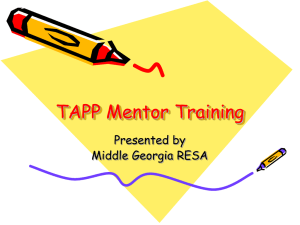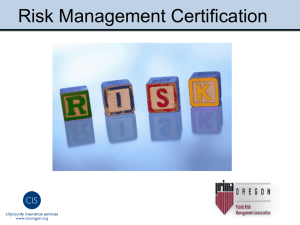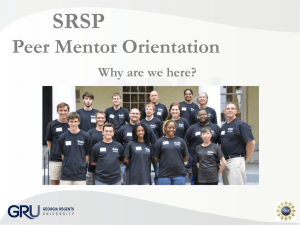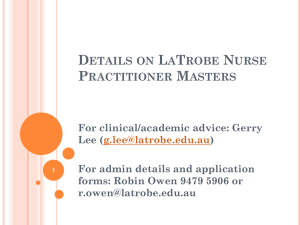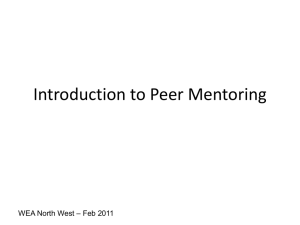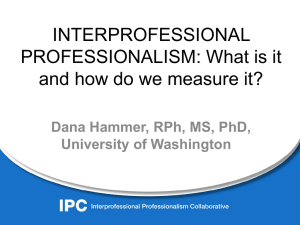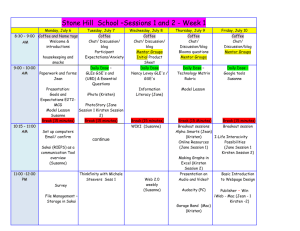Possibilities for patient involvement in medical education
advertisement
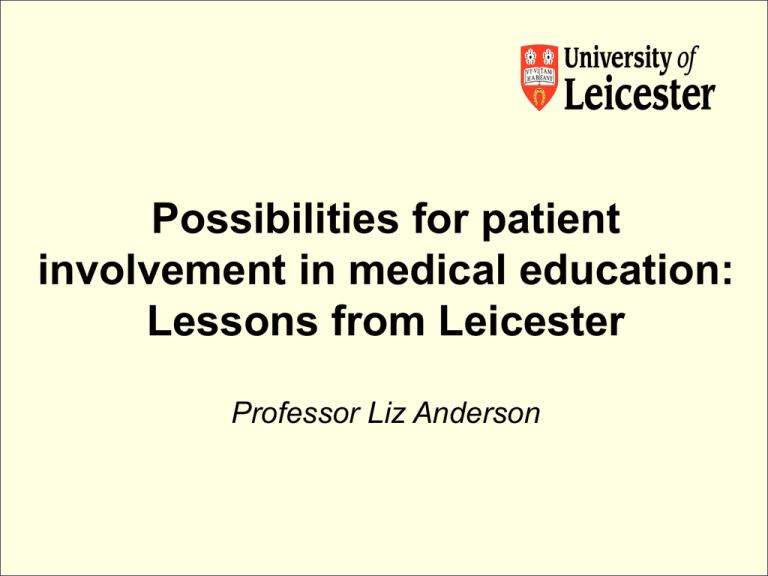
Possibilities for patient involvement in medical education: Lessons from Leicester Professor Liz Anderson Questions to ask ourselves • Are there different perceptions on what engagement means for patients/service users, students and faculty staff? • What does an authentic involvement mean for patients/service users, students and faculty staff? • What do students want? Paracelsus certainly recognised the value…. ‘….a good physician should be ready to learn from midwives, gypsies, nomads, brigands and others who live outside the law. He should inquire among all classes of people, seeking out everything that might contribute to his knowledge; he should travel widely, undergo many adventures, and learn, learn the while.’ (Paracelsus, 1493- 1541) Medical Education 1999;33:688-694 Results Patients as teachers (i) as experts in their condition – showing managing disability – clinical aspects etc. (ii) as exemplars of their condition (iii) as facilitators of the development of professional skills and attitudes Results • How patients benefitted from participation – – – – – through talking through learning about their condition through learning about the training of doctors by recognition of helping students' learning by feeling useful in providing practical help to students – receipt of appreciative gifts Medical Education 2010: 44: 64–74 doi:10.1111/j.1365-2923.2009.03530.x Problems • How to move beyond short projects • Integration within Faculty • On-going research required – Impacts on patients; students; curriculum Our Story • Recognition that patients perspectives are radically different from professionals Inequalities in health • 1995: ‘Health in the Community’ Stage 1. Immersion Students meet patients and carers in their care setting to listen to their experiences of health and social care and to explore their priorities. Interprofessional groups range from 2 to 4 students. Each small group then interviews all agencies caring for their patient to analyse their roles and responsibilities and priorities. Stage 4. Feedback Stage 2. Reflection Student teams present their findings and solutions and their recommendations to improve care and care delivery Debate and discussion lead to awareness of gaps in service delivery and care. Solutions can lead to changes as professional teams action the highlighted shortfalls in provision. Managers are in powerful positions to change and overcome practice barriers. Stage 3. Analysis The student team consider all aspects of the care package, including constraints on service, unmet needs, best practice to produce solutions to identified problems. In particular they compare patient and professional priorities to look for a fit or mis-match. They prepare a feedback to the PHCT. After each experience the student teams reflect on what they have learnt supported by facilitators. They are encouraged to relate profession specific theories and policies to issues they identify. Reflections enable students to learn about each professional domain. Inequities in Health • 1998: ‘Shaping our Future Medical Workforce’ DOH- ‘Learning from Lives’ Disability Social model of disability Teaching led by disabled people Leicester Centre for Integrated Living 1998-2008 Anderson, ES. & Smith, R. (2010). Learning from Lives together: lessons from a joint learning experience for . medical and social work students. Health and Social Care in the Community,18(3), 229-240 What next? • Patient involvement – Steering groups – Shaping teaching – Available in their own homes Next Steps: • Partnerships to design new teaching Research: Higher Education Academy UK 2008-2011 Stage One: Move to integrated model – Patients involved in the design of a teaching event in which they support the teaching Stage Two: Progress to empowerment – Patients move on to take on leading roles in teaching Method Exploratory Action Research Design; • reflective problem solving • collaborative • takes place in the social learning context • seeks to understand learning processes ‘to improve education by changing it and learning from the process’ Kemmis & McTaggart 2005 Action Research Cycle: Stage One Step 5: Embed Step 1:Planning Steering group Consultations Step 4: Implement changes Pilots, n= 69 students, additional, n=13 patients Step 3: Reflection Coffee morning wide patient engagement Step 2: Observing Pilot with n= 40 students and n= 10 patients The Patient Designed Learning Away day: First Model Students hear service user story Students discuss and reflect Student recommendations influence practice Students identify improvements Students take their learning into practice Interprofessional student groups have conversations with two service users Students and service users discuss the key messages for professional practice Students discuss what they learned Students present their learning in accessible formats to the participating service users and their peers The “Listening Workshop” 22 Patients Comments ‘ I think this is a wonderful idea it should be compulsory before anyone is let out there on “real” people. Practise on us, listen to what we have to say then the same mistakes won' won’t be made’, mother disabled child. ‘The whole experience of sitting down and talking to someone who’s been through it is completely and utterly different to just reading it in a book and more memorable because of it and will be more useful I hope..’ disabled adult. Patients Giving Feedback: comment ‘It did leave you thinking what have I put on my form and are they going to see it straight away? But then I thought about what I had put on the form and it was quite reasonable and that's OK. But I could have been in a position where I thought ‘Oh my God they are going to know exactly what I thought of them’, mother disabled child. Student Comment • Medical student ‘At medical school we are taught to take histories. The patient story is regimented according to the doctor’ s agenda. The Listening Workshop was therefore a challenge. We were told to shut up and listen: less questions, more attention and for the first time in a long time I sat and listened to the patient’s story in the way they wanted to tell it,’ focus groups extract. NEXT STEPS: Stage Two • Indications in early work of the desire and ability of some patients to take on a leading teaching roles. – Annually 11 events, some 596 students. • Second piece of research to consider what a leading role might look like Action Research Cycle: Stage Two Step 5: Final Agreement Step 1:Consultation meeting Coffee morning with patients and educators Step 4: Step 2: Focus Groups n=15 Patient workshop n=13 Student Focus groups n=25 Interviews: Patients n= 9 Staff n=3 Step 3: Consultation meeting Coffee morning wide patient engagement Patients Views New Roles: 1. 2. 3. 4. 5. 6. 7. Co-tutoring: helping to deliver the teaching Recruiting: supporting new people as a mentor Determining the curriculum Organising support groups Reading students work Student selection Confirm to employers who to select New Roles 1. Co-tutoring: helping to deliver the teaching 2. Recruiting: supporting new people as a Mentor Service user Comments ‘A good idea because otherwise you end up being a bit of a specimen… whereas if you’re a co-tutor it kind of forces them to listen to you more’. ‘I don’t think I personally want to be a co-tutor... I do think that as a service user certain people have a huge amount to offer… I am probably perfectly capable of doing it but its just a confidence thing’. ‘I see myself mentoring…I’ve had enough experience doing the workshops talking to students to be able to help other people and advise them’. Student Comments ‘It would be more helpful for us because any academic who hasn’t themselves been in that position do not actually know what the patients wants to tell’. ‘It would be very useful to back that up having patients teach us because we are here to learn from them’. ‘You know it would possibly improve attendance because you feel worse for letting down a patient who is taking their time to do it’. ‘Our normal tutors are trained to be tutors.. They need to sign our work… so I would rather have a tutor even if it was supervisory’. UNCERTAINTY Do patients have the authority? This will change the relationship. Will patients have the skills? Vulnerability of patients VALIDITY Yes with support; it’s their right. Social work students more comfortable with the idea. Would improve attendance. This event ideal for BALANCE leadership Student agenda versus Service user agenda “two sides of the coin TEACHING Teaching professionalism. Support for patients needed. Skills for this event. Suggested methods of training Full Report: March 2012 Anderson. ES., & Ford , J. (2012). Enabling Service Users to Lead Interprofessional Workshops to Improve Student Listening Skills. Higher Education Mini Grant, Subject Centre, Medicine, Dentistry and Veterinary Medicine. Project No: MP220. Newcastle. http://www.medev.ac.uk/funding/7/22/funded/ Training Programme New Roles Co-tutor & Mentor Four training sessions 1. 2. 3. 4. Common Induction: Adult Learning Common Induction: Professionalism in teaching Specific: Co-Tutor & Mentor Specific: Co-Tutor & Mentor (practice) Process: Shadowing, employment autumn 2012. Patient Unit • Agreement visions, payment scales, • Involvements – Teaching – Student Support – Student recruitment Ladder of service user involvement (Tew, Gell & Foster, 2004) LEVEL 5 Partnership LEVEL 4 Collaboration LEVEL 3 Growing Involvement LEVEL 2 Limited Involvement LEVEL 1 No involvement Patients work together with teaching staff across strategic and operational areas with an explicit statement of partnership values. Patients with secure contracts. Patients as full time department members involved as below in THREE major aspects of faculty work. The department has a statement of values. Training and supervision are offered. Patients involved in TWO of the following: planning, teaching delivery, student selection, assessment, management or evaluation. Payment at normal visiting lecturer rates. Training and support offered. Service users invited in to ‘tell their stories in a designated slot. No opportunity to shape the course. Payment offered. Curriculum planned, delivered and managed with no patient involvement. In Summary • Unanswered questions concerning the ‘professionalism’ of patients in medical education • Excellent and the reason for IPE • Challenging, time consuming, worthwhile Questions to ask ourselves • Are there different perceptions on what engagement means for patients/service users, students and faculty staff? • What does an authentic involvement mean for patients/service users, students and faculty staff? • What do students want?



